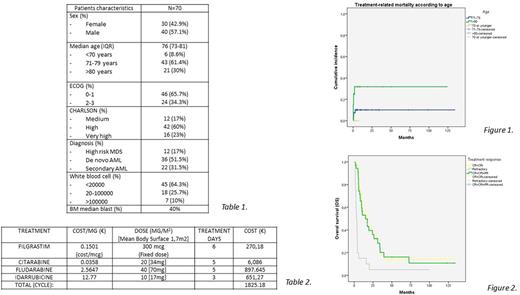Abstract

INTRODUCTION
Acute Myeloid Leukemia (AML) and high risk Myelodisplastic Syndrome (MDS) have a higher incidence in older patients. Due to their age, comorbidity and unfavorable biology of the disease, intensive chemotherapy offers poor results. Hypomethylating agents and other alternative regimens are being tested but the best strategy is currently not well defined.
OBJECTIVE
Updating the FLAGIDA-lite intermediate intensity chemotherapy scheme results (Am J Hematol. 2012 Jan;87(1):42-4). Rate of overall response (OR), overall survival (OS) and treatment-related mortality (TRM) were evaluated. An estimated cost approach and a review of the 5-azacytidine cost estimation was made.
PATIENTS AND METHODS
Seventy patients older than 65 years with AML or high risk MDS treated with the FLAGIDA-lite regimen in three Spanish centers between 2006 and 2016 were analyzed. Median age was 76 years (IQL 73-81) and patients´ characteristics are shown in table 1 . The regimen consisted of: Fludarabine (40mg/m2 daily, days 1-5, P.O), Citarabine (20 mg/m2 daily, days 1-5, sub-Q) and Idarrubicin (15 mg/m2 daily, days 1-3, P.O until 2014, or IV 10 mg/m2 daily, days 1-3 when oral formulation disappeared). G-CSF (300 µg/24h sub-Q, days -1 to 5) was added except when leukocytosis was greater than 100,000/µl. Treatment administration and subsequent follow-up were performed under hospitalization, home care or ambulatory regimen. We calculated the regimen costs.
RESULTS
Toxicity and Treatment Related Mortality
A total of 117 chemotherapy cycles were administered (80 as induction and 37 as consolidation).
Sixty-one (76.2%) induction and 34 (91.9%) consolidation cycles were administered under ambulatory or home care regimen; in 21 (34.4%) and 8 (21.6%) of them, respectively, hospital admission was necessary, mainly due to infectious complications.
Thirteen (18.6%) patients died after induction, 10 due to treatment-related complications and 4 due to disease progression. Early mortality at 8 weeks was 20.9%. Treatment-related mortality was higher in patients older than 80 years (30 vs 10%), as shown in figure 1.
Overall Response and Overall Survival
Sixty patients received one induction cycle and 10 received 2. OR rate was 64.9% (49.1% CR, 8.8% CRi; 7% PR) and 35.1% of patients were refractory. Median time to CR was 36 days (26-51). Twenty-six patients who had reached CR/CRi received consolidation with the same regimen (35 cycles) and 6 patients were submitted to a related allogeneic hematopoietic stem-cell transplantation.
With a median follow-up of 23.8 months (9-105) in alive patients, estimated OS at 2 years was 22.6 (±5.4%) in the whole series and 41.1% (±9.4%) in patients who reached CR/CRi, as shown in figure 2. Median OS in patients who reached CR/CRi was significantly higher than in non-responder patients (17.4 vs 2.9 months, p< 0,001).
Cost estimation
The cost of one cycle of FLAGIDA-lite, in Spain, is 1825.18 euros, as shown in table 2 . The median number of cycles administered in our study was 2, so the global cost of treatment drugs was 3650.36 euros. The estimated cost in Spain of another non-intensive regimen with not higher or similar efficacy (5-azacitidine) according to literature is 3028.14 euros each cycle and a total cost of 18,168.84 euros (median number of 6 cycles) . ( Health Econ Rev. 2013 Dec 5;3(1):28).
CONCLUSION
FLAGIDA-lite is an effective alternative regimen in elderly patients with AML and high risk MDS, with low treatment-related mortality in patients younger than 80 years (10%) and with the possibility of an ambulatory management. This treatment offers an overall response rate around 65%, and an estimated overall survival at two years around 41% in responder patients. Its cost is markedly lower than the cost of 5-azacytidine.
No relevant conflicts of interest to declare.
Author notes
Asterisk with author names denotes non-ASH members.

This icon denotes a clinically relevant abstract


This feature is available to Subscribers Only
Sign In or Create an Account Close Modal